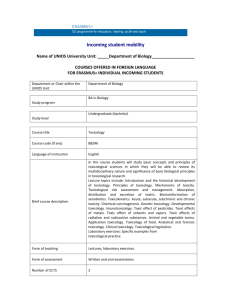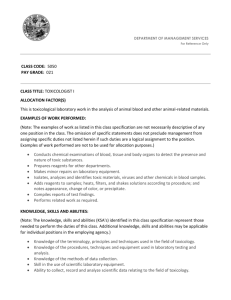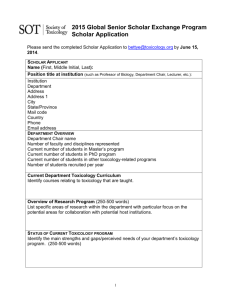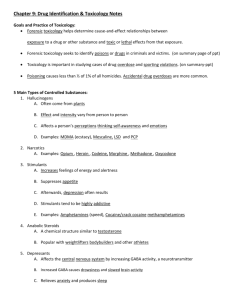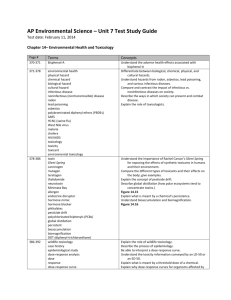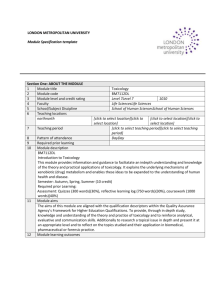ATS Application - Academy of Toxicological Sciences
advertisement
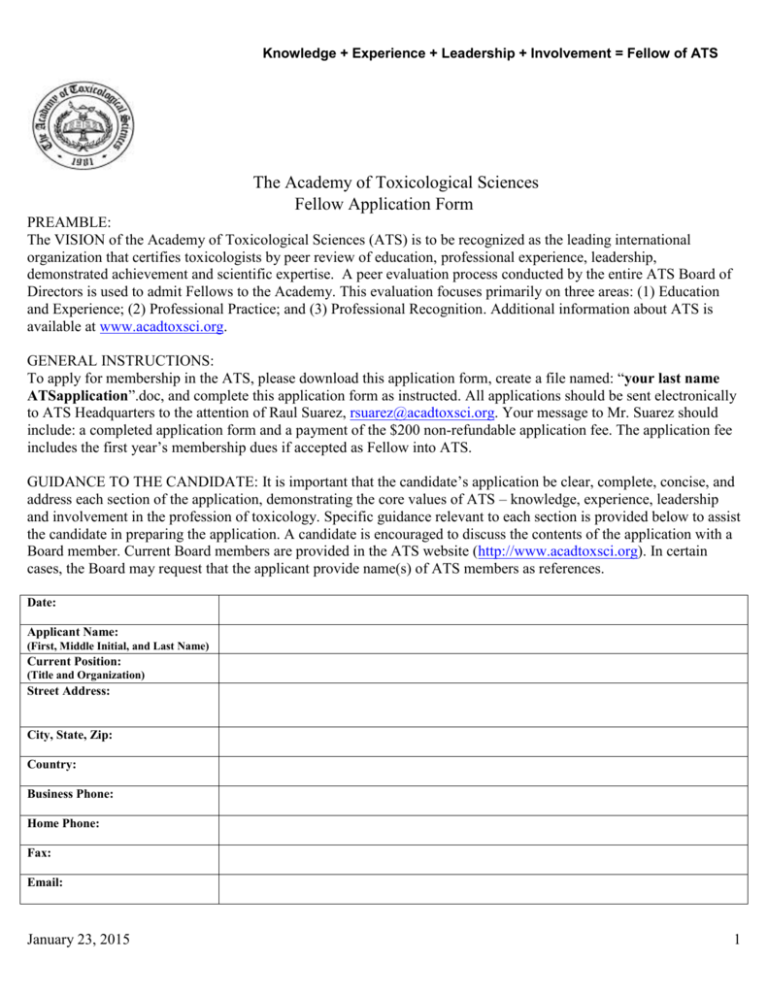
Knowledge + Experience + Leadership + Involvement = Fellow of ATS The Academy of Toxicological Sciences Fellow Application Form PREAMBLE: The VISION of the Academy of Toxicological Sciences (ATS) is to be recognized as the leading international organization that certifies toxicologists by peer review of education, professional experience, leadership, demonstrated achievement and scientific expertise. A peer evaluation process conducted by the entire ATS Board of Directors is used to admit Fellows to the Academy. This evaluation focuses primarily on three areas: (1) Education and Experience; (2) Professional Practice; and (3) Professional Recognition. Additional information about ATS is available at www.acadtoxsci.org. GENERAL INSTRUCTIONS: To apply for membership in the ATS, please download this application form, create a file named: “your last name ATSapplication”.doc, and complete this application form as instructed. All applications should be sent electronically to ATS Headquarters to the attention of Raul Suarez, rsuarez@acadtoxsci.org. Your message to Mr. Suarez should include: a completed application form and a payment of the $200 non-refundable application fee. The application fee includes the first year’s membership dues if accepted as Fellow into ATS. GUIDANCE TO THE CANDIDATE: It is important that the candidate’s application be clear, complete, concise, and address each section of the application, demonstrating the core values of ATS – knowledge, experience, leadership and involvement in the profession of toxicology. Specific guidance relevant to each section is provided below to assist the candidate in preparing the application. A candidate is encouraged to discuss the contents of the application with a Board member. Current Board members are provided in the ATS website (http://www.acadtoxsci.org). In certain cases, the Board may request that the applicant provide name(s) of ATS members as references. Date: Applicant Name: (First, Middle Initial, and Last Name) Current Position: (Title and Organization) Street Address: City, State, Zip: Country: Business Phone: Home Phone: Fax: Email: January 23, 2015 1 Knowledge + Experience + Leadership + Involvement = Fellow of ATS SECTION 1 – Education and Experience. (Maximum Points for Section 1 is 30; you must achieve a minimum of 20 points in this section) Section 1.1 – Degree in relevant field: Any scientific discipline that refers to toxicologically-relevant information and principles including, but not limited to: toxicology, pharmacology, biology, biochemistry. Specify only the highest degree obtained in the box below: PhD or equivalent doctoral degree (MD or DVM) is 10 points; Master’s degree is 8 points; and AB, BA, BS, or BVSc degree is 6 points. (Maximum points for Section 1.1 is 10) Degree (points): __________ Institution: ________________________________ Discipline : ________________________________ Year received: __________ Section 1.2 – Years of professional experience in the active practice of toxicology: Active practice in toxicology includes, but may not be limited to the design, conduct, management or interpretation of toxicological experiments, or assessing the relevance of results of either specific experiments or integrated experimental datasets to human, environmental or animal health. Provide the number of years of professional experience in toxicology since highest degree was granted using the following scale: 1 point per relevant year for doctoral degree, ¾ point per relevant year for MS degree, and ½ point per relevant year for BS degree, up to 10 points. Please note all that is required here is the number of years. The details of how those years have been spent are addressed later in this application. Using the number of years of professional experience since the highest degree was granted - for individuals with a doctoral degree, only use the years after postdoctoral experience (specify number of years: ______), calculate the number of points as specified above (Maximum points for Section 1.2 is 10): __________ Section 1.3 – Continuing education (CE) in toxicology beyond terminal degree: Continuing education in toxicology can include university, professional society-sponsored (SOT, ACT, DIA, etc.), and/or other courses or training related to toxicology. List the courses taken with the number of hours for each course. Also, provide organizational-sponsored courses that are directly applicable to toxicology. These organizations, for example, include Pharmaceutical Education Research Institute (PERI), NIH, Center for Professional Development, ACGIH, Contract Research Organizations (CRO), etc. It is best to always include a specific course even if uncertain that it applies. Each 8 hours of continuing education session is worth 1 point. Please note that neither attendance at professional society-sponsored meetings (e.g., without taking a CE course), nor teaching courses in toxicology are appropriate demonstrations of continuing your education in toxicology. Both of these areas are covered below in Section 2.3. List below continuing education courses in toxicology taken, and include number of hours for each course: Using the number of hours of continuing education (specify number of hours: ______), calculate the number of points as specified above (Maximum points for Section 1.3 is 10): __________ January 23, 2015 2 Knowledge + Experience + Leadership + Involvement = Fellow of ATS SECTION 2 – Professional Practice of Toxicology. (Maximum Points for Section 2 is 40; you must achieve a minimum of 30 points in this section) Section 2.1 – Publications: Publishing peer-reviewed papers, technical reports, major reviews, and/or book chapters is an important way to demonstrate prominence in the practice of toxicology. Section 2.1.1 – Five most significant peer-reviewed publications in toxicology (for applicants holding doctorate degrees, these papers should be from after postdoctoral training): These papers are defined by the candidate as those believed to have made an impact on the field of toxicology. The reputation of the journal in which the paper is published is considered. The number of authors associated with the publication, and whether the candidate is the senior or corresponding author also is considered. In the box below, provide complete citations of five (5) most significant peer reviewed publications. Please note that it is essential that you indicate (in a sentence of two) the significance of the paper to the field of toxicology, and your role in the publication if you are not the first or senior author of the paper. (Maximum Points for Section 2.1.1 is 10) Section 2.1.2 – Additional publications and other technical reports (Maximum Points for Section 2.1.2 is 10) Section 2.1.2a – Additional original peer-reviewed research publications: In the box below, provide complete citations for additional publications in peer-reviewed journals (beyond those listed above in Section 2.1.1) demonstrating experience in the practice of toxicology (limited to those beyond graduate or postdoctoral training). If possible, this list should start with the most recent publications, and it is expected that the candidate will be the senior or first author on most publications as his/her career advances. Section 2.1.2b: Other technical and confidential reports: Reports published in media other than peer-reviewed journals, or unpublished technical reports, can also demonstrate the practice of toxicology. In the box below, provide complete citations for technical and confidential reports published in media, other than peer-reviewed journals, and, if possible, describe type of peer-review such as submission to agencies, clients, internal organizational reviews. For confidential information reports, provide general description of activity. For all reports listed below, describe your role (approximate percent effort) in their preparation. Section 2.1.3 – Major reviews, books, book chapters, or integrated analyses prepared from data based on a variety of sources (Maximum Points for Section 2.1.3 is 5): In the box below, provide a listing of major reviews, books, book chapters, and/or integrated data analyses reports demonstrating experience in the practice of toxicology. For unpublished technical analyses/reports, provide a brief description of the nature of the effort and its context, scientific merits, and the impact of the effort in the field of toxicological sciences. Examples of reviews could include, but not limited to, submissions to regulatory authorities such as pesticide or drug registration monographs, ATSDR Health Criteria Documents, IRIS assessments, safety and risk assessments, etc. January 23, 2015 3 Knowledge + Experience + Leadership + Involvement = Fellow of ATS Section 2.2 – Editorial and peer-review responsibilities (Maximum Points for Section 2.2 is 5): Serving on editorial boards and/or actively participating in the peer-review process are important ways to demonstrate prominence in the practice of toxicology. In the box below, provide a listing of toxicology journals of which you have served on the editorial board, or as an editor or associate editor over the course of your career (specify the years of service). Include books or special issues of journals in which you have served as an editor. It is possible to actively participate in the peer-review process without serving on an editorial board. In the box below, provide a listing of journals for which you have served as a peer-reviewer, and the approximate number of journal papers peer-reviewed per year per journal over the last 5 years. Finally, in the box below, provide a listing of the titles of all peer reviews of governmental and non-governmental reports that you have completed over the course of your career, and that are not part of your routine job responsibilities (include date/year of review). Examples would include EPA IRIS, ATSDR Health Effects reports, IOM reports, etc. Section 2.3 – Participation in toxicology activities both external and internal to your professional responsibilities: Include membership in professional societies (SOT, ACT, ABT, ATS, IUTOX, ISSX, STP, Teratology Society, AAAS, ACS, SRA, and other toxicology related organizations); attendance at toxicology-related meetings and workshops (SOT, IUTOX, ISSX, SRA, Gordon Conferences, Teratology Society, ACS, etc.); teaching/administrative responsibilities related to advancement of toxicology practice, both internal and external to your organization; presentations at toxicology-related meetings (posters, platforms); presentations to external decision-making scientific panels (e.g., EPA, FDA, WHO, IARC, NTP, etc.). (Maximum points for Section 2.3 is 10) List below membership in all toxicology-related professional societies over the course of your career (specify the number of years as a member): List below attendance at toxicology-related meetings over the course of your career: January 23, 2015 4 Knowledge + Experience + Leadership + Involvement = Fellow of ATS List below presentations at toxicology-related meetings (posters, platforms), or to external decision-making scientific panels over the course of your career (Please note that invited presentations are requested below in Section 3.3, and should not be covered here). List below teaching/administrative responsibilities related to the advancement of the practice of toxicology – both internal and external to your organization – over the course of your career. SECTION 3 – Professional Recognition. (Maximum Points for Section 3 is 40; you must achieve a minimum of 30 points in this section) Section 3 – This section is intended to identify those activities demonstrating a high level of recognition for expertise in the practice of toxicology. In particular, this section seeks evidence that the candidate’s expertise is recognized and valued by third parties including both employers (Section 3.1), and external bodies of scientific peers (Section 3.2 and 3.3). Section 3.1 – Professional career advancement (Maximum Points for Section 3.1 is 10): As recognition of your leadership in toxicology, provide title(s) of positions held, and include a description of the position(s), demonstrating how each position reflects increasing responsibility and leadership during your employment history. Do not include positions held as part of academic training, such as instructor or post-doctoral positions and do not include adjunct appointments. List below title(s) of employment positions held, and include brief narrative as to how each position reflected increased responsibility and leadership in toxicology. List below internal institutional (employer) committees over the course of your career, and include brief narrative as to your role, and how your participation demonstrates leadership in toxicology: Section 3.2 – Recognition of prominence in the toxicological sciences (Maximum Points for Section 3.2 are 20): Outside (non-employer) activities associated with decision-making and/or advisory activities that demonstrate regional, national and international leadership and recognized expertise in the field of toxicology and recognition in application of toxicological principles should be documented. Examples include, but are not limited to, serving (though not as an employee) on national and international committees such as ICH, WHO, IARC, Colipa, JECFA, ECVAM, ICVAM, ILSI/HESI, IARC, NIH, NAS/NRC, FDA, EPA, MITI, WHO and other committees that have broad-reaching impact on the field of toxicology. While service on peer review committees is appropriate, it is not necessary to list individual grant reviews. Engaging in deliberations with or within a regulatory agency on an important toxicological matter, such as a registration decision, or a chemical classification, may also be evidence of significant recognition to toxicological sciences, and the candidate is strongly encouraged to provide an overview of January 23, 2015 5 Knowledge + Experience + Leadership + Involvement = Fellow of ATS one’s role in such activities. Finally, list elections and/or appointments to scientific and professional committees of toxicology-related organizations. List below service on national and international committees impacting the field of toxicology, and provide an overview of one’s role in such activities. List below all elected and/or appointed positions to scientific, professional, and/or institutional committees, and provide an overview of evidence of leadership responsibilities within such activities as clear demonstrations of contributions to toxicological science. List below any other related activities demonstrating prominence in the practice of toxicology over the course of your career. Section 3.3 – Recognition through invited lectures and presentations (Maximum Points for Section 3.3 are 5): In this section, the applicant should include invited lectures and presentations to major academic and non-academic institutions, organizations, and professional societies, including, but not limited to, national and international meetings on subjects related to toxicology. In the box below, provide a listing of all invited lectures and presentations in the toxicological sciences over the course of your career. The description should include the title of the presentation and the venue/organization with date and year. Section 3.4 – Scientific awards, citations and professional honors (Maximum Points for Section 3.4 are 5): This section should include certifications in toxicology such as DABT, ERT, JSOT, etc. Awards and professional honors given to the individual by the candidate’s employer or other external organizations should also be included, although more weight may be given to those awarded from external organizations. Particularly important are awards from major prominent scientific toxicology organizations. Scientific awards also include competitive grants or other types of external or internal funding provided by the government or other organizations. List in the box below, all scientific awards, citations and professional honors, including employer recognition awards, and competitive grants or other types of external or internal funding, and provide an overview of the relationship to toxicological sciences. ______________________________________________________________________________________________ SUMMARY – Minimum points required to be eligible for membership in the ATS: Section 1. Education Section 2. Professional experience Section 3. Professional recognition January 23, 2015 20 of 30 30 of 40 30 of 40 6 Knowledge + Experience + Leadership + Involvement = Fellow of ATS ______________________________________________________________________________________________ Send completed electronic application form to the attention of Raul Suarez at rsuarez@acadtoxsci.org. The $200 application fee can be paid via check or credit card. Checks should be mailed to ATS Headquarters, 1821 Michael Faraday Drive, Suite 300, Reston, VA 20190. Or send a message to Mr. Suarez, rsuarez@acadtoxsci.org, regarding payment by credit card. ATS accepts Master Card, Visa, and American Express. Your application will not be reviewed until payment is received. After your application has been reviewed, you will receive a letter outlining the Board’s decision. If approved, the first year of membership will be paid from the application fee. At the present time, annual dues are $125. Should your application not be approved during this initial review, you will be provided with the Board’s reasons for deferral as well as suggestions for improvement. All deferred applicants are entitled to reconsideration within a period of five years without payment of the additional application fee. ____ Yes, I would like my employer notified if I become a Fellow. Employer Name: _____________________________________________________________________ Employer Email Address: ______________________________________________________________ January 23, 2015 7



